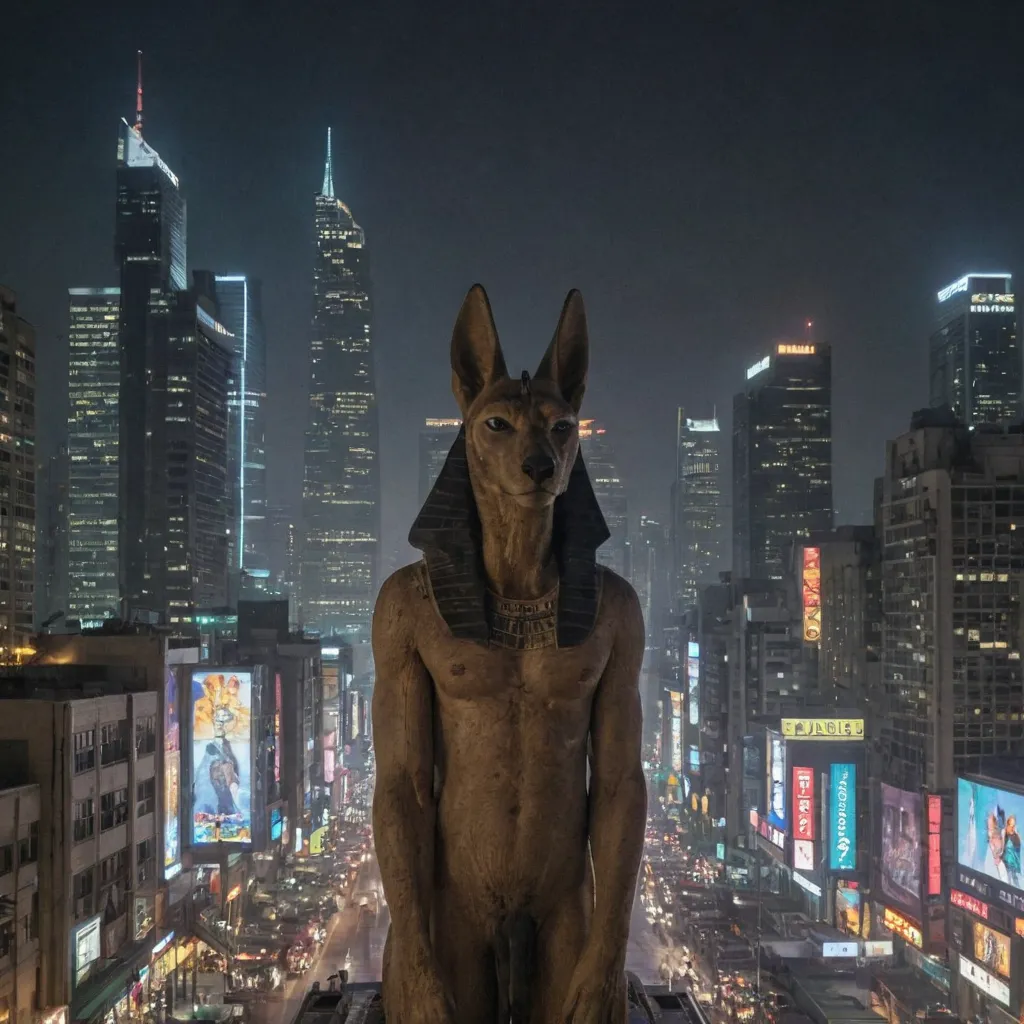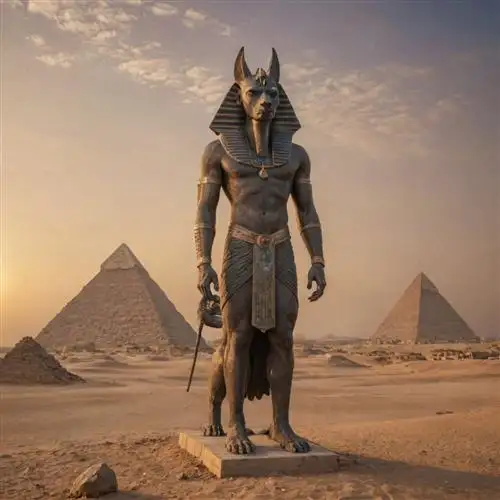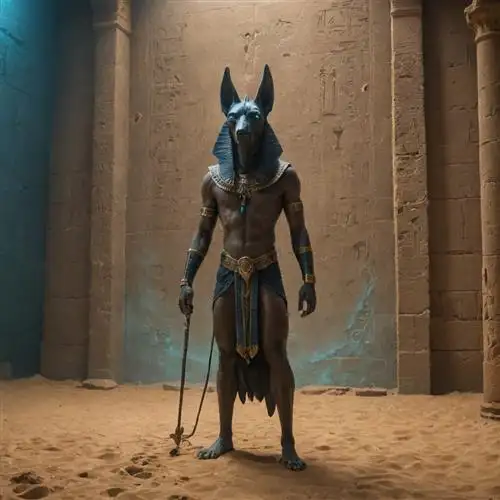
The Omnipresence of Anubis in Ancient Egyptian Mythology
Anubis, the jackal-headed god, holds a profound and multifaceted significance in the rich tapestry of ancient Egyptian mythology. Often associated with the afterlife and the mummification process, Anubis' symbolic influence transcends the boundaries of a single domain, permeating various aspects of the Egyptian belief system.
One of the most striking features of Anubis' presence in ancient Egyptian mythology is his role as the guardian of the dead. As the god responsible for the embalming and preparation of the deceased for their journey to the afterlife, Anubis was revered as a crucial figure in ensuring the successful transition of the soul. This sacred duty was not limited to the pharaohs or the elite; Anubis' protective mantle extended to all who passed from the mortal realm, making him a ubiquitous presence in the ancient Egyptian funerary landscape.
Beyond his role as the gatekeeper of the afterlife, Anubis also held significant symbolic meaning in the broader context of Egyptian mythology. As a deity associated with the embalming process, Anubis was seen as a symbol of preservation and transformation, representing the delicate balance between life and death. This duality, often depicted in his dual-natured iconography, established Anubis as a figure of both power and compassion, guiding the deceased through the challenges of the afterlife.
Interestingly, Anubis' omnipresence in ancient Egyptian mythology was not confined to the realm of the dead. The jackal-headed god also held sway in the world of the living, serving as a protector and guide for the living. In this capacity, Anubis was often invoked for his wisdom, his ability to navigate the complexities of the physical and spiritual realms, and his capacity to provide counsel and support to the living.
The symbolic importance of Anubis extends beyond his primary roles in the afterlife and the embalming process. The jackal-headed deity was also closely associated with the concept of justice and judgment, both in the mortal realm and the afterlife. As the one who weighed the hearts of the deceased against the feather of truth, Anubis played a pivotal role in determining the fate of the soul, ensuring that the balance of righteousness was maintained.
Anubis and the Afterlife: The Jackal God's Role in Death and Rebirth
Anubis, the enigmatic jackal-headed deity, has long held a revered and integral position within the pantheon of ancient Egyptian mythology. As the god of the dead, embalming, and the afterlife, Anubis's symbolism extends far beyond a mere funerary role. His influence and significance in the Egyptian journey of the soul are profound and multifaceted.
At the heart of Anubis's symbolism lies his intricate connection to the afterlife and the process of death and rebirth. As the guardian of the sacred necropolis and the embalmer of the deceased, Anubis was responsible for ensuring the safe passage of the dead into the next realm. This duty was not merely a practical one, but a deeply spiritual and transformative process.
Anubis's role as the ultimate guide and protector of the dead was multifaceted. He was believed to weigh the heart of the deceased against the feather of Ma'at, the goddess of truth and justice, to determine the worthiness of the soul. This pivotal judgment, known as the "Weighing of the Heart," was a crucial step in the Egyptian conception of the afterlife, as it determined whether the soul would be granted eternal life or condemned to oblivion.
But Anubis's symbolism extends beyond the realm of judgment and the afterlife. He was also revered as a deity of transformation and rebirth, a guardian of the liminal spaces between life and death. In this capacity, Anubis was seen as a facilitator of the cyclical nature of existence, guiding the deceased through the process of death and into the next phase of their spiritual journey.
The jackal-headed god's connection to the concept of rebirth is particularly intriguing. Anubis was often associated with the cycle of the sun, mirroring the daily death and resurrection of the celestial orb. This symbolism was further reinforced by his proximity to the mummification process, which was itself seen as a form of rebirth and rejuvenation for the deceased.
Moreover, Anubis's association with the jackal, a creature that thrives in the liminal spaces between the living and the dead, further underscores his role as a guardian of the transitional phases of existence. The jackal's ability to navigate the boundaries between the mortal and the divine realms was seen as a reflection of Anubis's own power to guide the dead through the treacherous journey to the afterlife.
The Symbolic Duality of Anubis: Life, Death, and Transformation
The ancient Egyptian god Anubis is a complex and multifaceted deity whose symbolism extends far beyond his traditional role as the god of mummification and the afterlife. At the core of Anubis' significance lies a profound duality, a delicate balance between the realms of life and death, and the transformative power that exists within this paradox.
Anubis' association with death and the funerary process is well-documented, as he was responsible for guiding the deceased through the dangerous journey to the afterlife. However, this role was not solely focused on the finality of death. Anubis also represented the crucial process of transformation, the rebirth and rejuvenation that occurs through the act of mummification and the passage to the next world.
This duality is further reflected in Anubis' iconography, which often depicts him as a jackal-headed figure or a pure jackal. The jackal, a creature that inhabits the liminal spaces between the living and the dead, symbolizes Anubis' ability to traverse these realms and facilitate the transition. The jackal's keen senses and adaptability were seen as essential qualities in navigating the complex and perilous journey to the afterlife.
Moreover, Anubis' role as a judge of the dead further emphasizes his symbolic duality. He was responsible for weighing the heart of the deceased against the feather of truth, a process that determined the individual's worthiness to enter the afterlife. This judgment not only evaluated the moral character of the deceased but also recognized the transformative potential within each soul, the opportunity for spiritual growth and enlightenment.
The significance of Anubis' symbolism extends beyond the realm of the afterlife. His association with the process of mummification, a practice that was believed to preserve the physical body and enable the soul's continued existence, connects him to the larger cycle of life, death, and rebirth. Anubis' presence in this sacred ritual underscores his role as a guardian of the transition, a facilitator of the transformation that occurs between the mortal and the divine.
The Enduring Legacy of Anubis: From Ancient Egypt to Modern Symbolism
Anubis, the jackal-headed Egyptian god, holds a revered position in the pantheon of ancient Egyptian deities. Far from being merely a relic of the past, the symbolism and significance of Anubis continue to resonate profoundly in the modern world. Delving into the depths of this enduring legacy reveals the multifaceted nature of this enigmatic figure and the profound impact he has had on human consciousness.
At the heart of Anubis' importance lies his role as the guardian of the dead and the overseer of the mummification process. In ancient Egypt, Anubis was responsible for ensuring the safe passage of the deceased into the afterlife, guiding their souls and protecting their mortal remains. This critical function elevated Anubis to a position of immense reverence, as the ancient Egyptians believed that the successful transition to the afterlife was essential for the continuation of life and the preservation of the individual's identity.
Beyond his role in the afterlife, Anubis also symbolized the fundamental duality of existence. As a jackal-headed deity, he embodied the balance between life and death, light and dark, and the cycle of rebirth and renewal. This duality was a central tenet of ancient Egyptian philosophy, and the veneration of Anubis reflected the deep human need to reconcile the seemingly opposing forces that shape our existence.
The enduring legacy of Anubis is further exemplified by his continued presence in modern symbolism and popular culture. From the use of the jackal or dog motif in various spiritual and esoteric traditions to the widespread incorporation of Anubis' image in contemporary art, literature, and media, the god's influence has transcended the boundaries of ancient Egypt.
In the field of psychology, the figure of Anubis has been interpreted as a representation of the unconscious mind, the instinctual and primal aspects of the human psyche that guide us through the shadowy realms of existence. This interpretation has resonated with modern thinkers and has contributed to the ongoing fascination with Anubis and his symbolic significance.
Moreover, the symbolism of Anubis has found its way into various esoteric and spiritual traditions, where he is often associated with the concepts of transformation, initiation, and the journey of the soul. In these contexts, Anubis is seen as a guiding force, a guardian who assists individuals in their personal and spiritual growth, helping them to navigate the complexities of the human experience.















